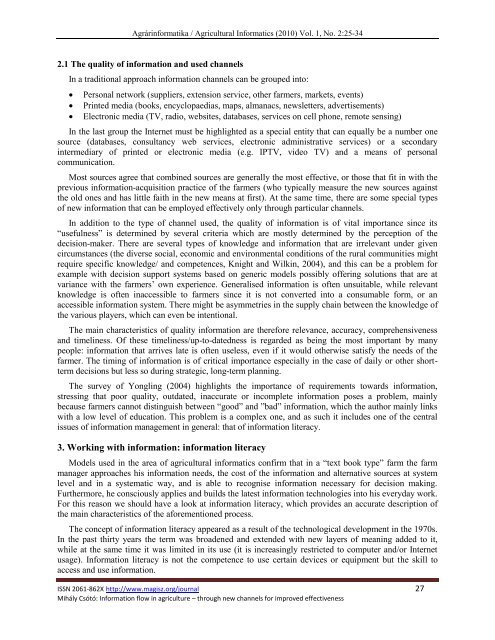The issue in pdf format, Vol 1, No 2 - Journal of Agricultural Informatics
The issue in pdf format, Vol 1, No 2 - Journal of Agricultural Informatics
The issue in pdf format, Vol 1, No 2 - Journal of Agricultural Informatics
You also want an ePaper? Increase the reach of your titles
YUMPU automatically turns print PDFs into web optimized ePapers that Google loves.
Agrár<strong>in</strong><strong>format</strong>ika / <strong>Agricultural</strong> In<strong>format</strong>ics (2010) <strong>Vol</strong>. 1, <strong>No</strong>. 2:25-34<br />
2.1 <strong>The</strong> quality <strong>of</strong> <strong>in</strong><strong>format</strong>ion and used channels<br />
In a traditional approach <strong>in</strong><strong>format</strong>ion channels can be grouped <strong>in</strong>to:<br />
<br />
<br />
<br />
Personal network (suppliers, extension service, other farmers, markets, events)<br />
Pr<strong>in</strong>ted media (books, encyclopaedias, maps, almanacs, newsletters, advertisements)<br />
Electronic media (TV, radio, websites, databases, services on cell phone, remote sens<strong>in</strong>g)<br />
In the last group the Internet must be highlighted as a special entity that can equally be a number one<br />
source (databases, consultancy web services, electronic adm<strong>in</strong>istrative services) or a secondary<br />
<strong>in</strong>termediary <strong>of</strong> pr<strong>in</strong>ted or electronic media (e.g. IPTV, video TV) and a means <strong>of</strong> personal<br />
communication.<br />
Most sources agree that comb<strong>in</strong>ed sources are generally the most effective, or those that fit <strong>in</strong> with the<br />
previous <strong>in</strong><strong>format</strong>ion-acquisition practice <strong>of</strong> the farmers (who typically measure the new sources aga<strong>in</strong>st<br />
the old ones and has little faith <strong>in</strong> the new means at first). At the same time, there are some special types<br />
<strong>of</strong> new <strong>in</strong><strong>format</strong>ion that can be employed effectively only through particular channels.<br />
In addition to the type <strong>of</strong> channel used, the quality <strong>of</strong> <strong>in</strong><strong>format</strong>ion is <strong>of</strong> vital importance s<strong>in</strong>ce its<br />
“usefulness” is determ<strong>in</strong>ed by several criteria which are mostly determ<strong>in</strong>ed by the perception <strong>of</strong> the<br />
decision-maker. <strong>The</strong>re are several types <strong>of</strong> knowledge and <strong>in</strong><strong>format</strong>ion that are irrelevant under given<br />
circumstances (the diverse social, economic and environmental conditions <strong>of</strong> the rural communities might<br />
require specific knowledge/ and competences, Knight and Wilk<strong>in</strong>, 2004), and this can be a problem for<br />
example with decision support systems based on generic models possibly <strong>of</strong>fer<strong>in</strong>g solutions that are at<br />
variance with the farmers’ own experience. Generalised <strong>in</strong><strong>format</strong>ion is <strong>of</strong>ten unsuitable, while relevant<br />
knowledge is <strong>of</strong>ten <strong>in</strong>accessible to farmers s<strong>in</strong>ce it is not converted <strong>in</strong>to a consumable form, or an<br />
accessible <strong>in</strong><strong>format</strong>ion system. <strong>The</strong>re might be asymmetries <strong>in</strong> the supply cha<strong>in</strong> between the knowledge <strong>of</strong><br />
the various players, which can even be <strong>in</strong>tentional.<br />
<strong>The</strong> ma<strong>in</strong> characteristics <strong>of</strong> quality <strong>in</strong><strong>format</strong>ion are therefore relevance, accuracy, comprehensiveness<br />
and timel<strong>in</strong>ess. Of these timel<strong>in</strong>ess/up-to-datedness is regarded as be<strong>in</strong>g the most important by many<br />
people: <strong>in</strong><strong>format</strong>ion that arrives late is <strong>of</strong>ten useless, even if it would otherwise satisfy the needs <strong>of</strong> the<br />
farmer. <strong>The</strong> tim<strong>in</strong>g <strong>of</strong> <strong>in</strong><strong>format</strong>ion is <strong>of</strong> critical importance especially <strong>in</strong> the case <strong>of</strong> daily or other shortterm<br />
decisions but less so dur<strong>in</strong>g strategic, long-term plann<strong>in</strong>g.<br />
<strong>The</strong> survey <strong>of</strong> Yongl<strong>in</strong>g (2004) highlights the importance <strong>of</strong> requirements towards <strong>in</strong><strong>format</strong>ion,<br />
stress<strong>in</strong>g that poor quality, outdated, <strong>in</strong>accurate or <strong>in</strong>complete <strong>in</strong><strong>format</strong>ion poses a problem, ma<strong>in</strong>ly<br />
because farmers cannot dist<strong>in</strong>guish between “good” and ”bad” <strong>in</strong><strong>format</strong>ion, which the author ma<strong>in</strong>ly l<strong>in</strong>ks<br />
with a low level <strong>of</strong> education. This problem is a complex one, and as such it <strong>in</strong>cludes one <strong>of</strong> the central<br />
<strong>issue</strong>s <strong>of</strong> <strong>in</strong><strong>format</strong>ion management <strong>in</strong> general: that <strong>of</strong> <strong>in</strong><strong>format</strong>ion literacy.<br />
3. Work<strong>in</strong>g with <strong>in</strong><strong>format</strong>ion: <strong>in</strong><strong>format</strong>ion literacy<br />
Models used <strong>in</strong> the area <strong>of</strong> agricultural <strong>in</strong><strong>format</strong>ics confirm that <strong>in</strong> a “text book type” farm the farm<br />
manager approaches his <strong>in</strong><strong>format</strong>ion needs, the cost <strong>of</strong> the <strong>in</strong><strong>format</strong>ion and alternative sources at system<br />
level and <strong>in</strong> a systematic way, and is able to recognise <strong>in</strong><strong>format</strong>ion necessary for decision mak<strong>in</strong>g.<br />
Furthermore, he consciously applies and builds the latest <strong>in</strong><strong>format</strong>ion technologies <strong>in</strong>to his everyday work.<br />
For this reason we should have a look at <strong>in</strong><strong>format</strong>ion literacy, which provides an accurate description <strong>of</strong><br />
the ma<strong>in</strong> characteristics <strong>of</strong> the aforementioned process.<br />
<strong>The</strong> concept <strong>of</strong> <strong>in</strong><strong>format</strong>ion literacy appeared as a result <strong>of</strong> the technological development <strong>in</strong> the 1970s.<br />
In the past thirty years the term was broadened and extended with new layers <strong>of</strong> mean<strong>in</strong>g added to it,<br />
while at the same time it was limited <strong>in</strong> its use (it is <strong>in</strong>creas<strong>in</strong>gly restricted to computer and/or Internet<br />
usage). In<strong>format</strong>ion literacy is not the competence to use certa<strong>in</strong> devices or equipment but the skill to<br />
access and use <strong>in</strong><strong>format</strong>ion.<br />
ISSN 2061-862X http://www.magisz.org/journal 27<br />
Mihály Csótó: In<strong>format</strong>ion flow <strong>in</strong> agriculture – through new channels for improved effectiveness



